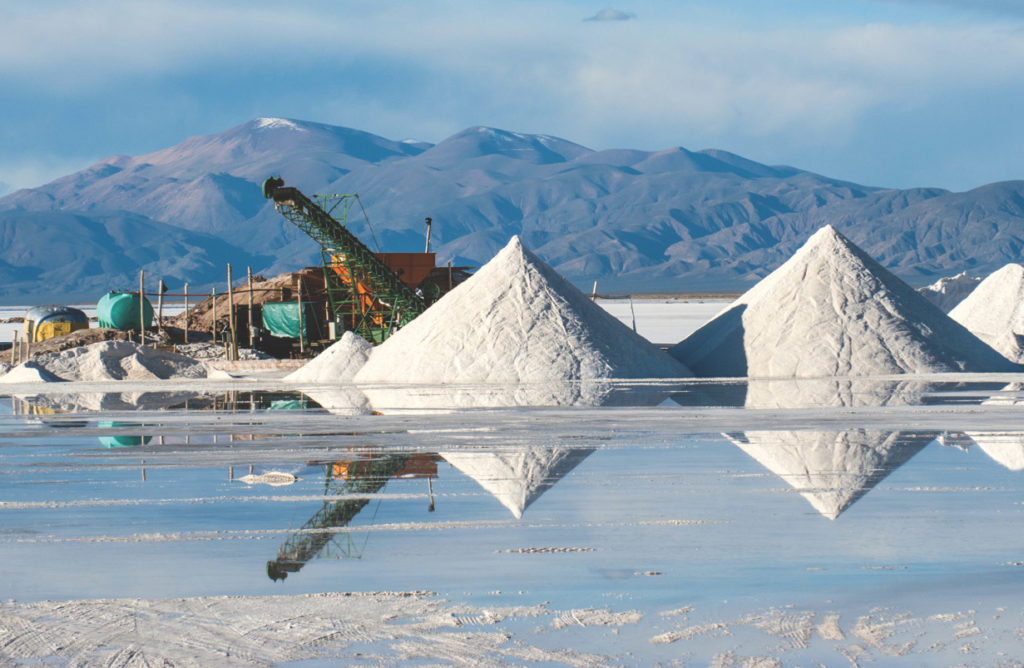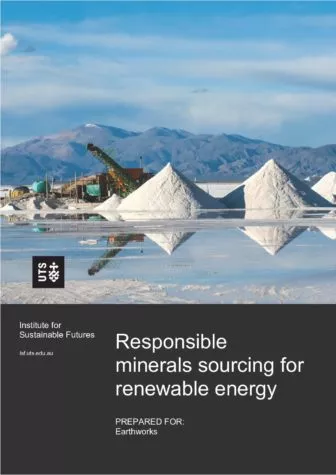We are in the midst of an urgent transition to renewable energy–a transition necessary to avert climate catastrophe. Yet clean energy infrastructure requires minerals that are dug out of the ground.
Lithium, cobalt and nickel—key minerals used to make the lithium-ion batteries used in electric vehicles (EVs)—are of principal concern, based on research Earthworks commissioned from the Institute for Sustainable Futures at the University of Technology Sydney. The skyrocketing demand for these minerals is driving the expansion of mining—and its destructive impacts on ecosystems and communities—in geographic “hotspots” throughout the world, including the ocean, with disproportionately negative impacts in the Global South.
In a 100% renewable energy future, demand could reach 136% of the documented nickel deposits that are economically feasible to extract, 280% for lithium and 426% for cobalt.
Impacts of Lithium Extraction
While there is a wide range of lithium extraction methods, two processes make up nearly all of today’s production today: hard-rock mining and evaporitic extraction from the brines below salt flats.
Hard-rock lithium mining in Western Australia is currently the largest source of production today. However, the vast majority of lithium deposits are found underneath the salt flats of Chile, Bolivia and Argentina.
Current operations, and a massive wave of exploratory work, are a source of socio-environmental disputes throughout this region. In the United States, particularly Nevada, several lithium projects at various stages of development are also the source of controversy and community concerns.

Impacts of Nickel Mining and Refining
Devastating cases of damage to freshwater and marine ecosystems have been documented in Canada, Russia, Australia, Philippines, Indonesia, Papua New Guinea and New Caledonia due to nickel mining and refining practices. Earthworks’s Ditch Ocean Dumping Campaign has been working to stop the practice of marine tailings disposal around the world, including in relation to nickel mines in Indonesia and Papua New Guinea.
Impacts of Cobalt Mining
The majority of global cobalt production is concentrated in two southern provinces of the Democratic Republic of Congo: Lualaba and Haut-Katanga. Industrial-scale copper-cobalt mines operated by a mix of state-owned, Chinese and multinational companies account for 80% of Congolese cobalt production.
Pollution from these operations impacts on public health and impedes the growth of agriculture and tourism—sectors that could help diversify the region’s economy and reduce its dependence on mining. Bribes of government officials by companies often prevent local communities and workers from reaping the economic benefits of these mines. Cases of illicit financial flows, tax evasion and other improprieties by large mining companies have reduced what little economic benefits the sector offers the country and affected communities.
While only producing an estimated 20% of Congolese cobalt, the artisanal cobalt mining sector has attracted the lion’s share of negative international attention, largely due to the presence of child labour in artisinal mining operations. Calls by artisanal mining cooperatives to make the sector safer and more viable for those who depend on it have largely been ignored by mining companies and downstream cobalt users.
Trends in Battery Chemistries and What it Could Mean for Lithium, Nickel and Cobalt Demand
Battery technology is evolving rapidly. In the near future we will likely see a wider range of battery types, each demanding different minerals.
Already we are seeing strong interest in a shift away from cobalt used for battery cathodes. Yet while this would reduce cobalt demand it would increase nickel or lithium demand. Such a shift would also have implications for future recycling efforts, given the relatively high value of cobalt.
From the Report: “A continued shift away from the dominant cobalt-rich LIB types and a broader shift away from LIB technology is predicted to meet future requirements for three important market sectors: long-range, high-utilisation (freight and public transport), and the low-cost market. Lithium-sulfur (Li-S) is considered the most prospective candidate to replace the currently dominant LIB types.”
Li-S battery chemistries are far more lithium intensive than their LIB counterparts, thus leading to the counterintuitive results in the graph below. Substantial leaps in lithium reuse and recycling, coupled with increased public transit could vastly reduce primary lithium demand.

The Path Forward
Mining is a destructive industry, long responsible for human rights abuses and environmental devastation. By reducing demand and increasing reuse of minerals, while demanding that mining only take place with consent, we can accelerate our renewable energy transition and push the mining industry to clean up its act.
In order to ensure that our clean energy economy is truly clean—as well as just and sustainable—we must develop a shared commitment to responsible mineral sourcing, recycling and reuse, coupled with a reduction in overall energy and mineral demand.
Related Content:
Your Support Makes Our Work Possible
Earthworks helps families on the front lines of mining, drilling, and fracking. We use sound science to expose health, environmental, economic, social, and cultural impacts of mining and energy extraction. To support our efforts, please consider a tax-deductible donation today that will go toward our work reforming government policies, improving corporate practices, influencing investment decisions, and encouraging responsible materials sourcing and consumption.


